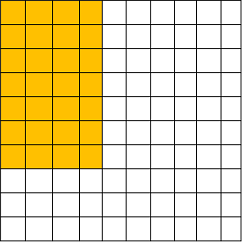The NWEA MAP Growth Test for 5th Grade reflects growing reasoning, problem-solving, and academic skills as students get ready for middle school. I’m Ariav Schlesinger, sharing clear insight to help families understand what this level of MAP Growth involves.
This page includes:
- Free 5th grade MAP sample questions
- Clear explanations of reading, math, and language skills
- A simple overview of MAP Growth content areas at this grade
- Guidance for interpreting your child’s MAP scores
- Helpful at-home tips and parent FAQs
Explore free questions and see how our PrepPack supports a confident transition to middle school.
Sample Math Questions | Sample Reading Questions | Sample Language Usage Questions | Scores Explained | How to Prep | Our PrepPack | FAQs
5th Grade MAP Test Sample Questions
Math
Strengthening Abstract and Analytical Thinking
At the 5th-grade level, the MAP Growth Math test challenges students to apply logical reasoning and abstract thinking to solve complex problems. They work with fractions, decimals, and variables, analyze numerical patterns, and learn to use parentheses and brackets in expressions. Students also explore geometry and measurement, identifying shapes, working with the coordinate plane, and applying formulas for volume and area. In data analysis, they interpret charts and tables, calculate averages, and make predictions based on data. Try the free sample math questions below to see the types of problems your child may encounter on test day.
Reading
Building Comprehension and Critical Thinking
The MAP Growth Reading test for 5th grade measures how well students understand and analyze a variety of texts, including literary passages, informational articles, and short excerpts. Students are asked to identify main ideas, themes, structures, and purposes within a text. They also use context clues, affixes, and vocabulary knowledge to determine word meanings. The test develops comprehension, inference, and analytical reading skills that are essential for academic growth. Explore the free sample reading questions below to see how your child can practice understanding complex passages and interpreting key details effectively.
Ready to Help Your Child Start Middle School Strong?
Confidence comes from preparation and the right tools make all the difference. Our 5th Grade MAP Growth PrepPack includes everything your child needs to strengthen essential skills, practice real test questions, and approach the MAP test with confidence.
Language Usage
Applying Grammar and Writing Skills
The 5th-grade MAP Growth Language Usage test evaluates how well students understand and apply the rules of written English. It covers mechanics like punctuation and spelling, grammar such as nouns, verbs, and sentence types, and usage involving correct sentence structure and word choice. Students also demonstrate writing skills by identifying tone, style, and purpose in short texts or paragraphs. This section helps measure a child’s readiness to communicate ideas clearly and accurately. Review the free sample language usage questions below to help your child practice editing, revising, and improving their writing.
Understanding MAP Growth Scores: What 5th Grade Parents Need to Know
As your child completes elementary school, MAP Growth scores provide crucial insights into their readiness for middle school. These scores are not just numbers. They reveal whether your 5th grader is prepared for the independence, organizational demands, and academic challenges that come with the transition to middle school.
What Are MAP Growth Scores?
After your child takes the MAP Growth Test, you'll receive a Family Report that shows how your child is learning and progressing over time. This report uses the RIT scale, a consistent measurement tool that tracks skills in reading, math, and language usage regardless of grade level.
Key Components of MAP Growth Scores
- Your child's Family Report includes four main measurements:
- RIT Score - Shows the difficulty level your child can handle and tracks growth over time
- Percentile Ranks - Compares performance to peers nationally
- Growth Norms - Measures progress compared to students at the same starting level
- Projected Proficiency - Predicts performance on future assessments and readiness for middle school coursework
Understanding RIT growth helps families and teachers set realistic goals and track learning progress as your child prepares to leave elementary school. Want to understand these scores in detail? Learn more about interpreting MAP Growth scores and what each metric means for middle school readiness.
5th Grade MAP Growth Test Preparation: Supporting Your Child's Middle School Transition
The 5th Grade MAP Growth Test is more than an assessment. It is a measure of readiness for the middle school environment. Strong scores demonstrate preparedness for changing classes, managing lockers, and the increased academic independence that defines middle school life.
Why 5th Grade MAP Scores Matter for Middle School
Academic Readiness
- Establishes strong elementary foundations before middle school
- Shows preparedness for pre-algebra concepts and multi-step problems
- Demonstrates reading comprehension for textbook learning
Transition Preparation
- Identifies strengths to build confidence before the change
- Highlights skills to strengthen over the summer
- Helps incoming middle school teachers understand your child's needs
Future Success
- Creates momentum for 6th grade achievement
- Develops learning habits for middle school independence
- Provides a growth baseline for tracking middle school progress
How Parents Can Support MAP Growth Preparation at Home
Strengthen Reading Skills
- Read together and discuss stories, articles, or informational texts
- Ask questions about main ideas and supporting details
- Practice summarizing what your child has read
Build Math Confidence
- Work through multi-step word problems together
- Review multiplication facts and fraction concepts
- Practice explaining mathematical thinking out loud
Foster Independence
- Encourage your child to complete homework without constant reminders
- Help create organizational systems for materials and assignments
- Practice time management skills for middle school's faster pace
Prepare for the Change
- Talk positively about middle school opportunities and experiences
- Visit the middle school if possible to reduce anxiety
- Frame the MAP test as helpful feedback, not a high-pressure exam
Our 5th Grade MAP Growth Preparation Pack: Your Middle School Readiness Solution
We created the 5th Grade MAP Growth Preparation Pack specifically to prepare students for middle school success. This comprehensive resource strengthens the core skills needed for 6th grade while building confidence during this significant transition from elementary school.
What's Included in the MAP Growth Preparation Pack
Full-Length Practice Tests
- Simulates the adaptive MAP testing experience
- Builds focus and endurance for middle school assessments
- Familiarizes students with question formats and pacing
Step-by-Step Practice Quizzes
- Focused drills in foundational math and pre-algebra readiness
- Reading comprehension passages at 5th grade difficulty levels
- Grammar and language usage aligned with middle school expectations
Study & Parent Guides
- Practical tips for tracking RIT growth over time
- Strategies for developing strong study habits
- Clear explanations of how scores reflect middle school readiness
Why This MAP Growth Preparation Pack Prepares Students for Middle School
Builds Middle School-Ready Skills
- Strengthens math foundations for 6th grade success
- Develops reading comprehension for content-area classes
- Masters language conventions for middle school writing
Increases RIT Scores
- Consistent practice leads to measurable score improvement
- Targeted review addresses knowledge gaps before middle school
- Adaptive practice mirrors the actual MAP Growth Test format
Reduces Transition Concerns
- Students enter middle school confident and prepared
- Parents understand their child's academic standing clearly
- Progress tracking shows readiness for new challenges
Works with Family Schedules
- Self-paced materials that fit busy lifestyles
- Requires just a few sessions per week
- Aligns with NWEA standards for authentic preparation
Ask Ariav

Ariav Schlesinger is a certified teacher with a Master's in Education and a MAP Growth specialist with over a decade of experience developing 5th Grade MAP-aligned questions. His materials provide clear explanations that strengthen core skills in math, reading, and language usage. They prepare 5th graders for middle school success and help students feel confident taking the MAP Growth test.
NWEA MAP Test FAQs
At the 5th-grade level, the MAP Growth test becomes more analytical and abstract. Students face multi-step word problems in math, more complex texts in reading, and writing questions that test grammar and sentence construction. The test adapts to each child’s performance, showing whether they are ready for middle school-level reasoning and independence. It’s designed to measure growth, not memorization, so students can show what they’ve learned throughout elementary school.
While the MAP test doesn’t assign a pass or fail grade, the results have real academic impact. Teachers use MAP Growth scores to guide placement in middle school classes, identify enrichment opportunities, and track readiness for pre-algebra, complex reading comprehension, and independent writing. Preparation helps your child feel confident, reduce test-day anxiety, and demonstrate their true ability, not just what they recall under pressure.
The 5th Grade MAP Growth test covers three main subjects: Math, Reading, and Language Usage.
Math: Fractions, decimals, variables, geometry, and data analysis.
Reading: Identifying main ideas, analyzing structure, and interpreting vocabulary in context.
Language Usage: Grammar, punctuation, sentence structure, and writing organization.
Together, these sections measure readiness for middle school coursework, where students must apply their skills across subjects.
Our comprehensive PrepPack includes:
Full-length adaptive practice tests mirroring real MAP Growth questions.
Step-by-step quizzes for targeted review in math, reading, and language usage.
Answer explanations written by certified teachers to build conceptual understanding.
Parent and study guides for tracking progress and setting goals.
The pack strengthens academic foundations while preparing students for the middle school learning environment.
The PrepPack is designed to fit into family life with short, focused sessions, just 20–30 minutes a few times per week. Start by taking the diagnostic test to identify strengths and weaknesses. Then, use the topic-based practice sections to build skills in smaller chunks. Encourage your child to review the detailed explanations after each question as this transforms every mistake into a learning opportunity.
Most families begin 4–6 weeks before the test, but even a few days of guided practice can make a difference. Early preparation helps students review key concepts, build test stamina, and enter the testing period with confidence. If your child is transitioning to middle school, consistent MAP-style practice throughout the year helps maintain steady academic growth and confidence.
Yes. Because the MAP test is adaptive, the PrepPack is built for a wide range of ability levels. Each question set adjusts in difficulty, helping both high achievers and students who need extra support. Whether your child is aiming to reach grade-level proficiency or accelerate beyond it, the materials offer structured, self-paced practice to match their needs.
MAP Growth scores give teachers detailed insight into what your child knows and what they’re ready to learn next. Schools often use 5th-grade MAP results to plan middle school placement, differentiated instruction, and individual learning goals. Strong performance can indicate readiness for advanced math or accelerated reading programs.
Test anxiety is common, especially during transition years. Encourage your child to see the MAP test as a tool for learning, not a judgment of ability. Review sample questions together so the format feels familiar. Ensure good sleep, a calm morning routine, and positive encouragement. Emphasize effort and growth rather than perfection. Confidence and familiarity go a long way toward strong results.




